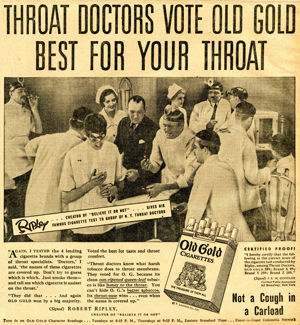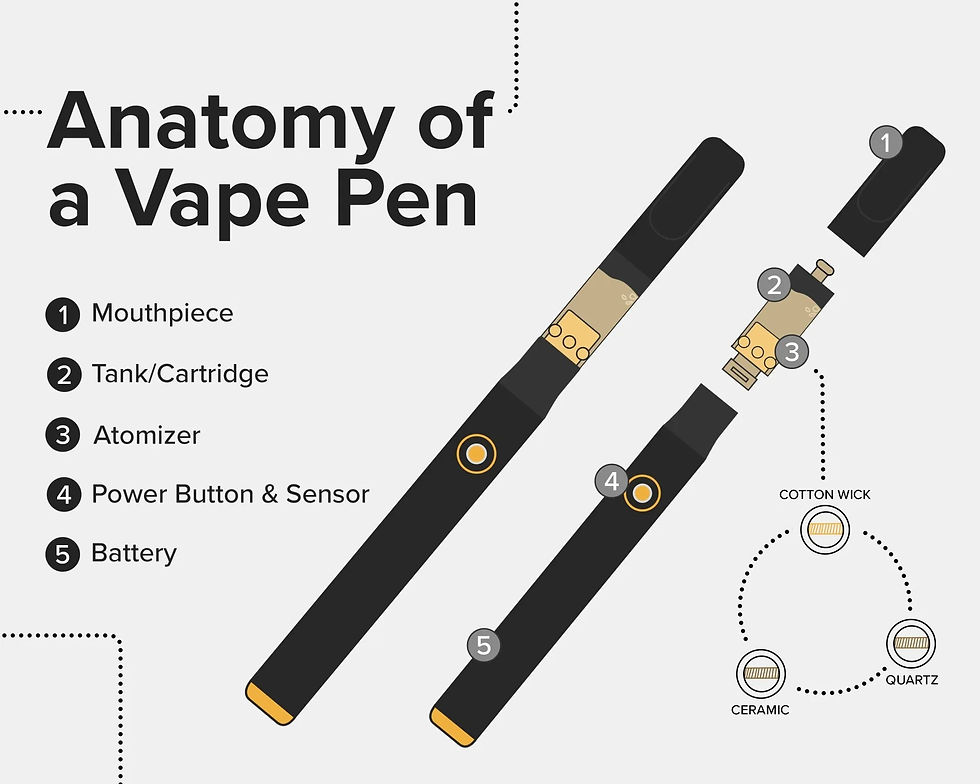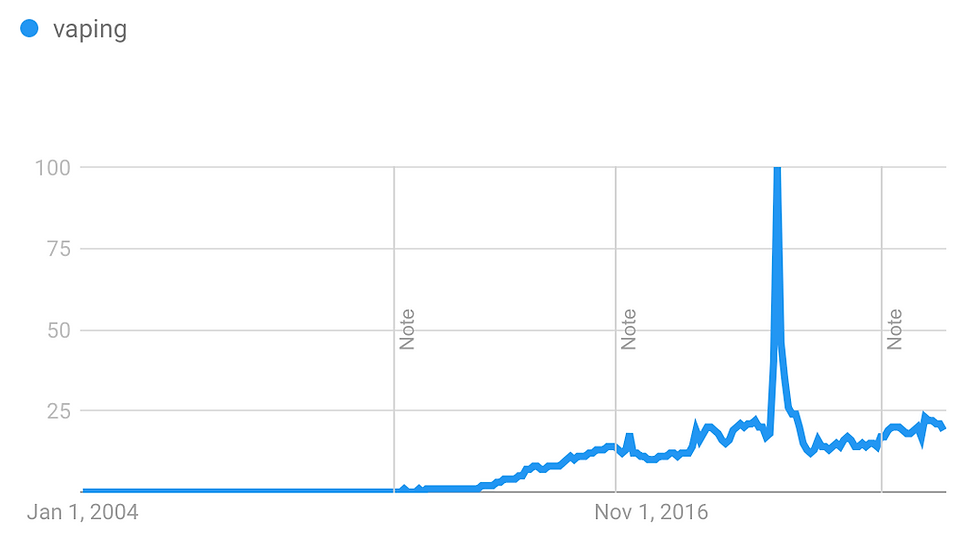Is Vaping a Safe Alternative to Smoking?
- Amal Heda
- Mar 21, 2022
- 4 min read
Updated: Jun 6, 2023
With vaping gaining traction amongst Gen-Z as an alternative to traditional cigarettes, it is important to explore this form of smoking and its safety.

The short answer?
No, not really.
The robust answer requires a comparison of both methods, so let’s begin with traditional cigarettes:
When cigarettes first came on to the scene:
This form of smoking was first introduced to the United States in the 19th century and by the Civil War, cigarette use had grown in popularity.This led to a large cigarette manufacturing industry and the cigarette’s ascension to America’s major tobacco product. For a considerable time, cigarettes were seen as non-threatening, with any opposition stemming from moral and hygienic concerns as opposed to safety and health. In fact, at one point, cigarette companies were employing pseudo-scientific “research” to assure the public of cigarette’s safety and were plastering doctors all over their advertising to further sell the notion that cigarettes were “safe” or “doctor recommended”.

Eventually, scientific studies with merit surfaced. They linked smoking to lung cancer and other diseases, and discovered that smoking not only affects the smoker, but also affects those around them via second hand smoke. These discoveries led to prohibition of smoking in several places, such as government facilities, commercial U.S. flights, the White House, and so forth. The Army and Navy even ceased cigarette rations for troops. In 1992, the EPA classed ETS (secondhand smoke) as a Group A carcinogen, which is the most dangerous class. Then around 1994-1998, a total of 46 states filed suit against the tobacco industry aiming to recover costs from tobacco related illnesses. In 1998, the suit was settled with $206 billion to be paid through 2025. In 1999, as part of the Master Settlement Agreement, tobacco companies agreed to removal of advertising across the country with remaining time on billboard leases turned over to states for anti-tobacco messages. In 2000, the Supreme Court determined that the FDA lacks the power to regulate tobacco products. Thus rendering the FDA’s proposal to limit access and appeal of tobacco products null and void.
So what exactly is vaping?:
The main components of a vape pen include the mouthpiece (the site where you inhale the vapors), the cartridge/tank (where one can refill and replace the drug), and the atomizer (generates the heat which converts the drug into a vapor).

Much like their counterpart (cigarettes), vape pens contain nicotine, while also containing their own host of chemicals and flavorings.The “e-cigarette” was introduced to the U.S. in 2006, by Chinese pharmacist and researcher Hon Lik. According to Google Trends data for the search terms “vaping” and “electronic cigarettes”, it appears that interest in vaping and similar forms of tobacco use have heightened in recent years (with notable peaks in 2019).


A contributing factor to their rise in popularity can be chalked up to similar tactics to those of cigarette campaigning. In the earlier stages of advertising, companies like JUUL pedaled upbeat and patently youth-oriented advertising and events to market their product.

Much like the doctors used in advertising to assure cigarette’s “goodness” and harmlessness, this upbeat campaigning evokes feelings of lightheartedness, happiness, and most dangerously, youth and “cool” in relation to e-cigarettes and vaping. What’s more is that JUUL held launch parties and events to further drive this happy-go-lucky image.

This trendy image and appeal to youth is something the company later attempted to deny, but thanks to those like Dr. Robert Jackler, co-founder of SRITA and the power of the internet, there are archives full of campaign imagery and promotional events which affirm the dangerous product positioning. In response to pushback, JUUL and others modified advertising to appeal to older individuals. Yet still, positioning of vape products and e-cigarettes for youth and as trendy still thrive on youth saturated media like TikTok through user generated posts. The question then remains, is this an amicable state? Is vaping preferable to smoking?
Vaping vs. smoking, the bare facts:
According to Johns Hopkins Medicine, while vaping exposes you to fewer toxins, there is still much to be said for what toxins it does expose a user to. Amongst the known substances include pesticide and two flavorings linked to toxic effects and respiratory irritation (and that doesn’t cover the thousands of unknown ingredients in vape pens). Data suggests potential for chronic lung disease and asthma with vaping. And with dual vaping and smoking, a potential for cardiovascular disease. Electronic cigarettes due to nicotine content are just as addictive as traditional cigarettes (and research suggests that nicotine may be as addictive as heroin and cocaine). And with vaping there is potential to inhale higher levels of nicotine thanks to extra strength cartridges and e-cigarette voltage for a greater “hit”.
In all, while vaping may contain fewer toxins, the things it does contain (+ potentially dangerous unknown substances), the data suggesting negative effects, and the presence of nicotine allowing for equal or elevated levels of addiction as compared to cigarettes doesn’t exactly make it a glorious alternative. In fact, vaping may just serve as a gateway to smoking.
Michael Blaha, Professor of Medicine at Johns Hopkins says vaping is not a safe practice and that it has a “gateway effect”. According to Blaha “literature suggests that 2 million young adults use electronic cigarettes as their first nicotine-based product. They’re not trying to quit smoking - they’ve never smoked before.” He says evidence suggests that young people who vape are likely to go on to use illicit drugs and tobacco products like cigarettes. He is concerned that we may be causing a smoking epidemic through youth addiction to electronic cigarettes early on in life.
End of the line:
Above all, we need to realize that just because something is trendy or popular doesn’t mean that it is safe or right. Rather than roll with the crowd, it is important to be active learners and consumers. And for those struggling with any form of addiction and for those who desire to quit, know that you are not alone. Please reach out. The Truth Initiative is a great resource to learn about the dangers of smoking, vaping and nicotine addiction. They have 24/7 support dedicated to helping vape users quit.



Bezpieczeństwo alternatyw dla tradycyjnego palenia to temat, który budzi wiele dyskusji. Wiele osób szuka mniej szkodliwych opcji, ale warto pamiętać, że nie tylko e-papierosy są alternatywą. Dla tych, którzy cenią sobie aromatyczne doznania i spokojny rytuał palenia, świetnym wyborem może być fajka wodna. Na https://smokelab.pl/ru/ można znaleźć szeroki wybór fajek wodnych oraz melas, w tym także beznikotynowych, co pozwala dostosować doświadczenie do własnych potrzeb. Ważne jest, by świadomie wybierać to, co się pali, i dbać o jakość używanych produktów, by czerpać z nich maksymalną przyjemność.
AV在线看 AV在线看;
自拍流出 自拍流出;
国产视频 国产视频;
日本无码 日本无码;
动漫肉番 动漫肉番;
吃瓜专区 吃瓜专区;
SM调教 SM调教;
ASMR ASMR;
国产探花 国产探花;
强奸乱伦 强奸乱伦;
代发外链 提权重点击找我;
谷歌蜘蛛池 谷歌蜘蛛池;
Fortune Tiger…
Fortune Tiger…
谷歌权重提升/ 谷歌权重提升;
谷歌seo 谷歌seo;
谷歌霸屏 谷歌霸屏
蜘蛛池 蜘蛛池
谷歌快排 谷歌快排
Google外链 Google外链
谷歌留痕 谷歌留痕
Gái Gọi…
Gái Gọi…
Dịch Vụ…
谷歌霸屏 谷歌霸屏
负面删除 负面删除
币圈推广 币圈推广
Google权重提升 Google权重提升
Google外链 Google外链
google留痕 google留痕
代发外链 提权重点击找我;
谷歌蜘蛛池 谷歌蜘蛛池;
Fortune Tiger…
Fortune Tiger…
谷歌权重提升/ 谷歌权重提升;
谷歌seo 谷歌seo;
谷歌霸屏 谷歌霸屏
蜘蛛池 蜘蛛池
谷歌快排 谷歌快排
Google外链 Google外链
谷歌留痕 谷歌留痕
Gái Gọi…
Gái Gọi…
Dịch Vụ…
谷歌霸屏 谷歌霸屏
负面删除 负面删除
币圈推广 币圈推广
Google权重提升 Google权重提升
Google外链 Google外链
google留痕 google留痕
代发外链 提权重点击找我;
蜘蛛池 蜘蛛池;
谷歌马甲包/ 谷歌马甲包;
谷歌霸屏 谷歌霸屏;
谷歌霸屏 谷歌霸屏
蜘蛛池 蜘蛛池
谷歌快排 谷歌快排
Google外链 Google外链
谷歌留痕 谷歌留痕
Gái Gọi…
Gái Gọi…
Dịch Vụ…
谷歌霸屏 谷歌霸屏
负面删除 负面删除
币圈推广 币圈推广
Google权重提升 Google权重提升
Google外链 Google外链
google留痕 google留痕